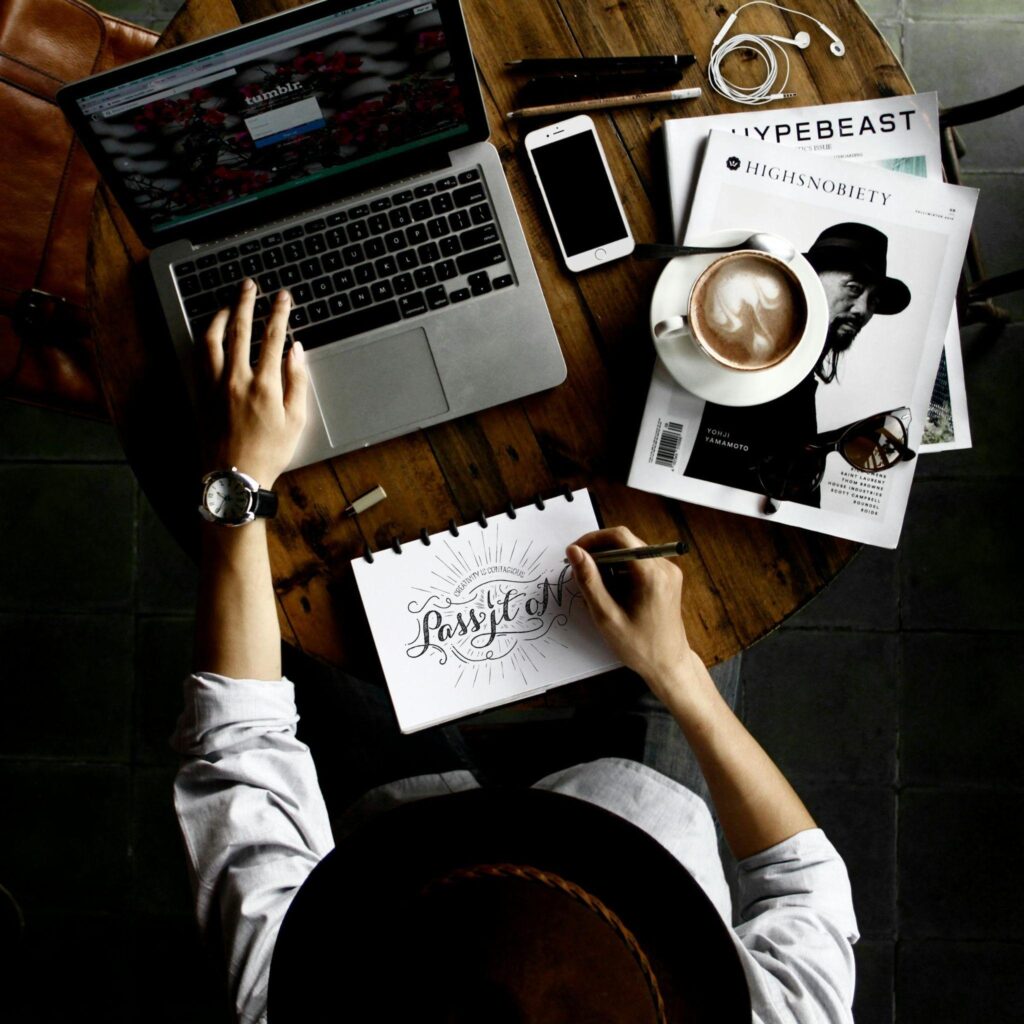
Picture this: you’re scrolling through your phone, half-distracted, when a logo catches your eye. Something about it just… clicks. You pause. You tap. You buy.
That split-second decision? It wasn’t random. Your logo just did something most business owners dream about—it turned a casual browser into a paying customer.
Most people think logos are just pretty pictures. They’re wrong. Dead wrong. A well-crafted logo is your silent salesperson, working 24/7 to build trust, spark recognition, and—here’s the kicker—boost your conversion rates in ways you probably never imagined.
Why Your Logo Is Your First (and Most Critical) Sales Tool
You’ve got about 50 milliseconds. That’s how long visitors spend forming their first impression of your website. Not fifty seconds. Fifty milliseconds.
Your logo isn’t just sitting there looking pretty—it’s making or breaking that crucial first moment. Think about it: when someone lands on your site, what’s the first thing they see? Your logo. And in that blink-of-an-eye moment, they’re already deciding whether you’re trustworthy, professional, or worth their time.
Here’s what blows my mind: companies spend thousands on conversion optimization, A/B testing every button color and headline… but they slap together a logo in five minutes and wonder why their sales are flat.
The psychology is simple. Humans are pattern-recognition machines. We see a logo and instantly categorize: “This looks legit” or “This screams amateur hour.” That snap judgment ripples through everything—trust levels, perceived value, willingness to share personal information, and yes, the likelihood of making a purchase.
How Professional Logo Design Builds Instant Trust and Credibility
Trust is everything in business. And nothing kills trust faster than a logo that looks like it was designed by someone’s nephew who “knows Photoshop.”
Think about the brands you trust most. Apple. Nike. Amazon. Their logos didn’t happen by accident. Each one was crafted to communicate specific values: innovation, performance, reliability. When you see that swoosh or bitten apple, your brain doesn’t just recognize the brand—it recalls every positive association you’ve built with it.
But here’s where it gets interesting: this trust-building happens even with brands you’ve never heard of. A professionally designed logo triggers what psychologists call the “halo effect.” People assume that if you invested in quality design, you probably invest in quality products and services too.
I’ve seen this play out countless times. Two identical e-commerce sites, same products, same prices. The only difference? One has a polished, professional logo. The other looks like it was thrown together in Microsoft Paint. Guess which one converts better?
The professionally branded site doesn’t just win by a little bit—it often converts at double or triple the rate. Why? Because trust isn’t just about security badges and testimonials. It starts the moment someone sees your logo.
The Psychology Behind Logo Recognition and Brand Memory
Your brain is incredibly efficient at storing visual information. You can recognize Apple’s logo in a fraction of a second, even if it’s partially hidden or distorted. That’s the power of visual memory—and it’s exactly what you want working for your business.
When customers see your logo repeatedly, something magical happens in their minds. Each exposure strengthens the neural pathway associated with your brand. First impression, second glance, third encounter—each one builds on the last until your logo becomes instantly recognizable.
But recognition alone isn’t enough. The real magic happens when your logo triggers positive emotions and memories. Maybe they remember that great customer service experience. Maybe they recall how your product solved their problem. Whatever it is, your logo becomes a shortcut to all those good feelings.
This is why consistency matters so much. Every time someone sees your logo—on your website, business cards, social media, packaging—you’re reinforcing that neural pathway. You’re making it easier for them to remember you, trust you, and ultimately, buy from you.
Specific Ways Logo Quality Directly Impacts Conversion Metrics
Let’s get specific about how logo quality affects your bottom line. The numbers don’t lie, and they’re more dramatic than most people realize.
Time on site increases dramatically with professional branding. Users spend an average of 38% longer on websites with cohesive, professional design elements—starting with the logo. More time on site means more opportunity to convert.
Bounce rates drop significantly when visitors see professional branding. A cheap-looking logo signals “amateur operation,” and people leave. A polished logo suggests quality throughout, encouraging people to stick around and explore.
Click-through rates on ads improve when your logo looks professional. The same ad with the same copy will perform differently based solely on logo quality. Professional logos get clicked more often because they look more trustworthy.
Form completion rates go up when people trust your brand from the first glance. Think about it—would you enter your email address on a site with a sketchy logo? Neither would your customers.
Social sharing increases with brands that look professional. People are more likely to share content from companies that look established and credible. Your logo quality directly impacts your organic reach.
Common Logo Mistakes That Kill Conversions (And How to Fix Them)
The biggest conversion killer? Trying to say everything in your logo. I see this constantly—business owners cramming their company name, tagline, phone number, and kitchen sink into one cluttered mess.
Your logo isn’t a billboard. It’s a signature. Keep it simple, memorable, and scalable. If it doesn’t look good when it’s the size of a postage stamp, it’s too complicated.
Color psychology matters more than you think. Red can trigger urgency (great for sales), but it can also signal danger (bad for trust). Blue builds trust but might feel cold for creative businesses. The wrong color choice can unconsciously push people away from your “buy now” button.
Generic fonts scream “template.” If your logo uses the same font I’ve seen on a dozen other websites this week, you’re not building brand recognition—you’re creating brand confusion. When in doubt, invest in custom typography or at least choose something distinctive.
Scalability issues hurt mobile conversions. More than half your traffic is probably coming from mobile devices. If your logo looks fuzzy, cramped, or unreadable on a phone screen, you’re losing sales before people even see your products.
The ROI of Investing in Professional Logo Design
Here’s what most business owners get wrong about logo design: they see it as an expense instead of an investment. They’ll spend $500 a month on Google Ads but balk at spending $1,000 on a logo that’ll work for years.
The math is simple. A professional logo might cost you a few thousand dollars upfront. But if it increases your conversion rate by even 1%, the payback happens fast. Really fast.
Let’s say you get 10,000 website visitors a month and convert 2% of them into $100 customers. That’s $20,000 in monthly revenue. A professional logo that bumps your conversion rate to 3% adds $10,000 in monthly revenue. Your logo pays for itself in a matter of weeks, then generates pure profit for years.
Now, you might need more than just a logo—maybe marketing materials, social media graphics, or other brand assets that all work together. That’s where having a reliable design partner becomes helpful. Companies like Superside can handle the whole visual ecosystem, but honestly, the key is just making sure everything feels cohesive, however you choose to get there.
But the benefits go way beyond direct conversions. Professional branding lets you charge premium prices. It makes partnerships easier. It attracts better employees. It creates brand loyalty that turns one-time buyers into lifetime customers.
The companies that understand this—that see branding as an investment rather than a cost—they’re the ones pulling ahead while their competitors wonder why their conversion rates are stuck in neutral.
What Makes a Logo Conversion-Friendly in Today’s Digital Landscape
Today’s logos need to work harder than ever before. They’re not just going on business cards and storefronts anymore—they’re showing up in Instagram stories, email signatures, mobile apps, and video thumbnails.
Simplicity wins every time. The most conversion-friendly logos are the ones that work in any context, at any size. Think about how Netflix simplified their logo to just the company name in a clean, bold font. No fancy graphics, no complicated elements—just clear, instant recognition.
Versatility is non-negotiable. Your logo needs to look great in full color, black and white, and everything in between. It should work on light backgrounds, dark backgrounds, and busy patterns. If you need six different versions for different situations, your logo is too complicated.
Cultural sensitivity matters more than ever. With global e-commerce, your logo might be seen by people from dozens of different cultures. Colors, symbols, and even fonts can have different meanings around the world. What looks professional in one culture might seem unprofessional—or worse—in another.
The best logos feel both timeless and current. They don’t chase trends that’ll look dated in two years, but they also don’t look like they’re stuck in 1995. They strike that perfect balance between classic and contemporary that makes people feel confident about doing business with you.
So here’s the real question: when someone sees your logo for the first time, what story does it tell? Does it whisper “trust me” or does it shout “proceed with caution”? Because in those crucial milliseconds before they decide to stay or go, your logo is doing all the talking.




